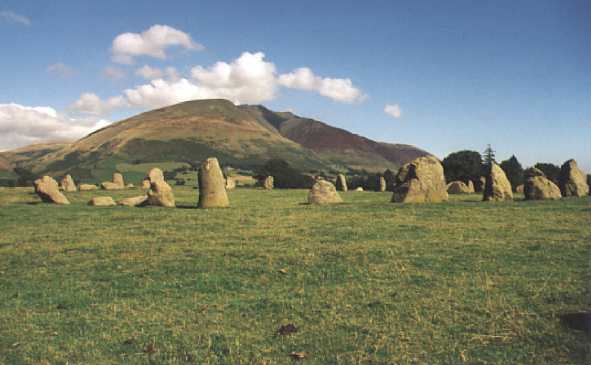 In a field about a mile and a half east by
north of Keswick, the remains of a Druids' Temple occupy a circular area of
thirty-eight yards in diameter, surrounded by thirty-eight rough stones, from three to
eight feet in height, and having ten other stones within, forming a square on its eastern
side. King Arthur's Round Table, near Lowther, on the south bank of the river
Eamont, hard by Penrith, is a trenched amphitheatre, the scene of many a tournament, where
the brave of other days vindicated their knighthood by feats of arrms.1
It is twenty-nine yards in diameter, with two apertures where the champions entered. The
Druidical Remains, called Long Meg and her Daughters, situated about half a mile
south of the church of Addingham, and about six miles north-east of Penrith, are supposed
to be of great antiquity, but whether they were intended for judicial rites, or for the
superstitious solemnities of the Druidical religion, is not now easy to determine. They
consist of sixty-seven unhewn upright stones, forming a circle of 350 feet in
diameter; some of the stones are ten feet high and fifteen feet in circumference, and one,
which stands about twelve yards from the others, is fifteen feet in circumference,
eighteen feet high, and weighs sixteen and a half tons; it is nearly square, and is so
placed that each angle answers to a cardinal point of the compass. This is called
"Long Meg," and the others, "her daughters." Near this principal
stone, four others form a square, and towards the east, west, and north, two stones of
great magnitude stand at a wider distance from each other than any of the rest, apparently
to form the entrances into the circle. Our astonishment is heightened on viewing this
circle, by the consideration that there is no quarry in the neighbourhood from which the
stones could have been obtained; but the Druids may have possessed a mechanical art of
which we are ignorant, by which these stones could be removed. Dr. Stukeley asserts that
all the great stones forming Stonehenge, on Salisbury Plain, were brought from Marlborough
Downs, a distance of fifteen miles, and that one of them weighed forty tons, and would
require one hundred and forty oxen to draw it!
In a field about a mile and a half east by
north of Keswick, the remains of a Druids' Temple occupy a circular area of
thirty-eight yards in diameter, surrounded by thirty-eight rough stones, from three to
eight feet in height, and having ten other stones within, forming a square on its eastern
side. King Arthur's Round Table, near Lowther, on the south bank of the river
Eamont, hard by Penrith, is a trenched amphitheatre, the scene of many a tournament, where
the brave of other days vindicated their knighthood by feats of arrms.1
It is twenty-nine yards in diameter, with two apertures where the champions entered. The
Druidical Remains, called Long Meg and her Daughters, situated about half a mile
south of the church of Addingham, and about six miles north-east of Penrith, are supposed
to be of great antiquity, but whether they were intended for judicial rites, or for the
superstitious solemnities of the Druidical religion, is not now easy to determine. They
consist of sixty-seven unhewn upright stones, forming a circle of 350 feet in
diameter; some of the stones are ten feet high and fifteen feet in circumference, and one,
which stands about twelve yards from the others, is fifteen feet in circumference,
eighteen feet high, and weighs sixteen and a half tons; it is nearly square, and is so
placed that each angle answers to a cardinal point of the compass. This is called
"Long Meg," and the others, "her daughters." Near this principal
stone, four others form a square, and towards the east, west, and north, two stones of
great magnitude stand at a wider distance from each other than any of the rest, apparently
to form the entrances into the circle. Our astonishment is heightened on viewing this
circle, by the consideration that there is no quarry in the neighbourhood from which the
stones could have been obtained; but the Druids may have possessed a mechanical art of
which we are ignorant, by which these stones could be removed. Dr. Stukeley asserts that
all the great stones forming Stonehenge, on Salisbury Plain, were brought from Marlborough
Downs, a distance of fifteen miles, and that one of them weighed forty tons, and would
require one hundred and forty oxen to draw it!There are several other interesting antiquities in this county, all of which will be noticed in the topographical part of this volume. Remains of ancient castles are to be seen at Carlisle, Cockermouth, Egremont, and Penrith. The principal monastic remains are at St. Bees, and Calder Abbeys, between Ravenglass and Whitehaven, and two of smaller dimensions, called Lanercost Priory, two miles east-north-east of Brampton, and Wetheral Priory, near Corby Castle.2
Mannix & Whellan, History, Gazetteer and Directory of Cumberland, 1847